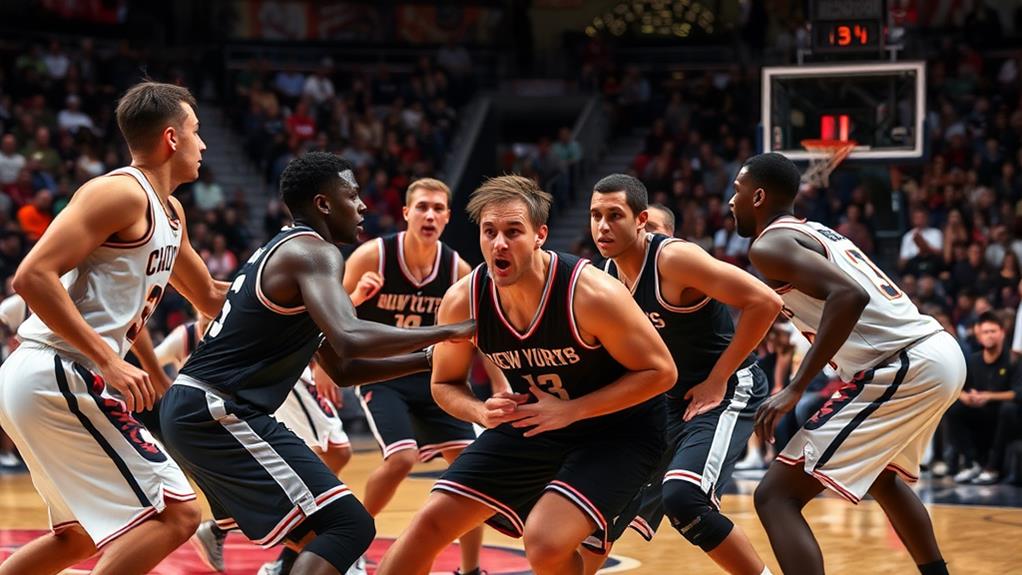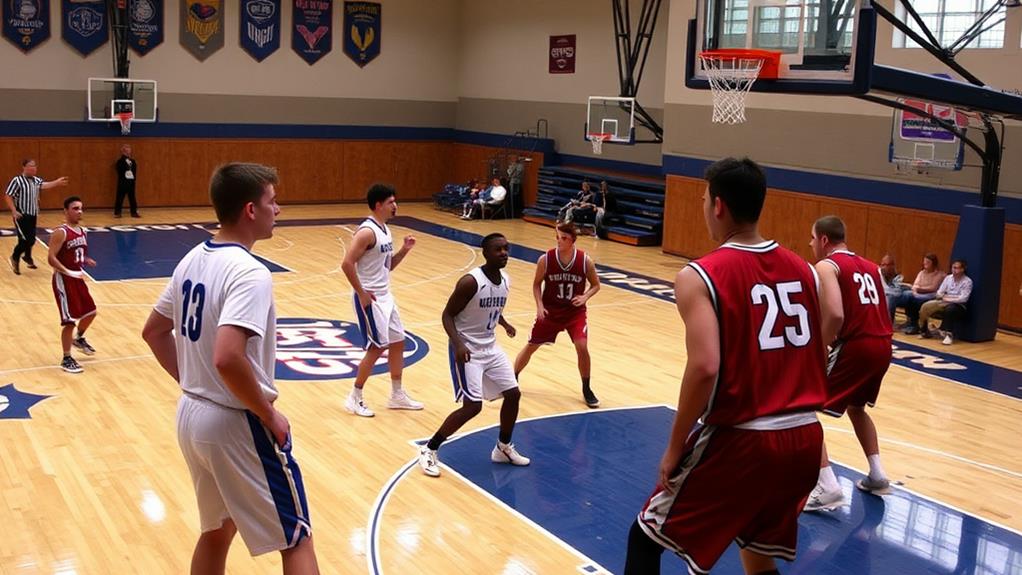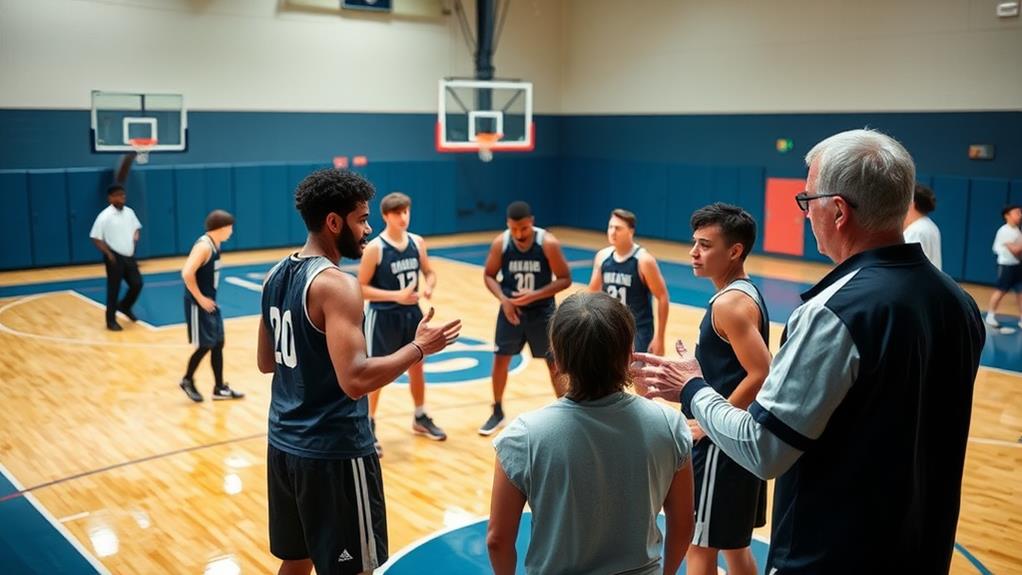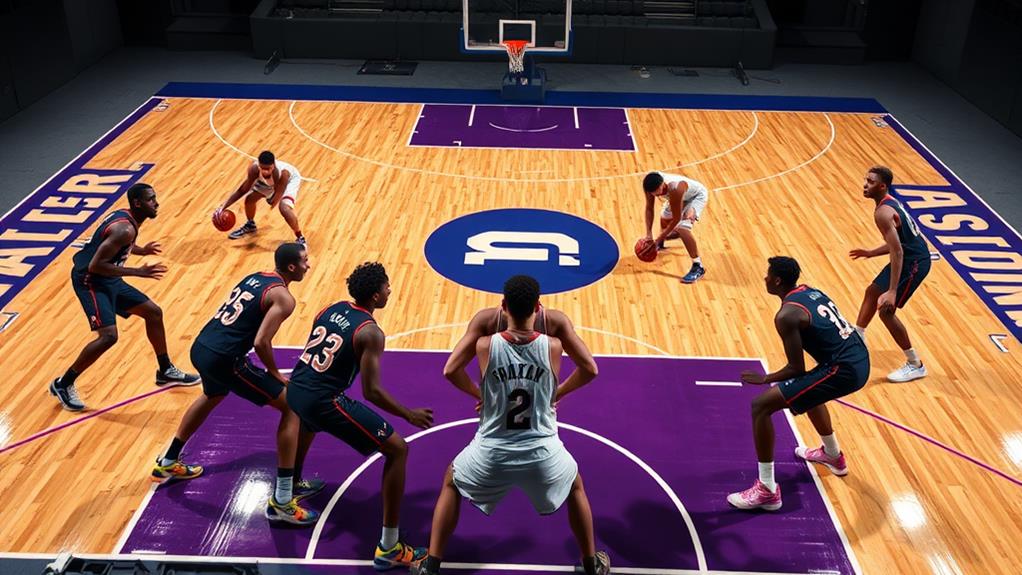
How to Execute the Diamond Press in Basketball
October 6, 2024To execute the Diamond Press in basketball, start by assigning clear roles to your players. The front defender pressures the ball handler and guides them toward the sideline. Second-level defenders must close passing lanes and communicate effectively. When you set up traps, move in quickly as a pair, keeping your hands high to block vision. Maintain a strong defensive mindset and use verbal and non-verbal cues to coordinate. Regular practice drills can sharpen your skills and timing. Master these basics, and you'll soon grasp more advanced techniques to boost your team's defensive game.
Understanding the Diamond Press
The Diamond Press is a strategic defensive maneuver that can change the momentum of a basketball game. It's also known as the 1-2-1-1 zone press, where you apply immediate pressure on the ball handler while your teammates position themselves to cut off passing lanes and sideline access.
This press works wonders, especially against teams with young players who might struggle with handling the ball under pressure. By leveraging data-driven strategies to analyze opponents' weaknesses, teams can effectively execute the Diamond Press with precision and adaptability.
To execute the Diamond Press effectively, you need to make sure the front defender stays in front of the ball handler. The two players behind must anticipate possible passes and look to create traps.
Communication is key; you and your teammates should always be aware of the ball handler's options and ready to react accordingly.
Practicing trapping techniques and situational drills regularly will help build your confidence and proficiency in executing the Diamond Press during games.
Key Objectives of the Press
Executing the Diamond Press means keeping your team focused on specific objectives that maximize its effectiveness. The primary goal is to create consistent defensive pressure that disrupts your opponent's ability to advance the ball and implement their offensive strategy. By aggressively trapping and cutting off passing lanes, you'll make it difficult for teams with weak ball handlers to maintain control.
Modern defensive strategies have evolved to emphasize adaptability, allowing teams to adjust their press based on the opponent's offensive style, reflecting the need for a versatile approach in today's game evolving gameplay.
Your intent is to force turnovers and capitalize on the mistakes that arise from pressure. The press limits easy scoring opportunities by pressuring players with the ball and encouraging errant passes, which can lead to scoring chances for your defense.
Maintaining defensive intensity is essential; you aim not just to force violations like 10-second calls and traveling but also to break your opponent's competitive spirit. Effective communication and teamwork among your players are important. Each player must understand their defensive roles, working together to maximize pressure and exploit weaknesses in the opponent's offense.
Player Roles and Responsibilities

In the Diamond press, each player's role is vital for its success. Understanding the fundamental principles of defense, such as pressure and cover, will enhance the effectiveness of your team strategy.
You'll need to understand your responsibilities, from the front defender pressuring the ball handler to the second level defenders cutting off options. This coordinated effort is essential for limiting the opponent's passing options and creating turnovers, emphasizing the importance of effective teamwork in defense.
Don't forget about the safety player, who serves as your last line of defense against any sneaky plays.
Front Defender Duties
Front defenders play an essential role in the diamond press, primarily tasked with containing the ball handler and applying relentless pressure. Your main goal is to stay in front of the ball handler, forcing them toward the sideline to limit their options. Encourage them to use the sideline as a boundary, which shrinks their space and increases trapping opportunities.
To excel in your duties, maintain a low defensive stance and utilize quick lateral movements. Keep your hands high to contest passes without fouling. A keen awareness of the second-level defenders' positioning is important; communicate effectively to guarantee passing lanes are covered and support is available for trapping.
Anticipating ball handler strategies is fundamental. Read their eyes to predict their next move, positioning yourself for potential steals. Good defensive footwork will help you stay agile and reactive, allowing you to adjust to the ball handler's movements.
As you practice different press variations, be sure to refine your skills, focusing on pressure application and teamwork. By mastering these duties, you'll greatly enhance your team's effectiveness in executing the diamond press.
Second Level Tasks
Positioned just behind the front defenders, second level defenders play a pivotal role in the diamond press by cutting off sideline access and closing passing lanes. Your primary focus should be on cutoff strategies that limit the ball handler's options.
Maintain proper positioning to anticipate their movements; this way, you're always ready to trap when the chance arises. Effective communication with the front defender is vital. It helps you coordinate traps and coverage, ensuring everyone's on the same page.
Keep your hands high and feet active to discourage passes, and always be prepared to switch roles if the press is broken. Passing lane awareness is essential in this role. By staying alert, you can intercept passes or force the ball handler into difficult decisions.
If the press is bypassed, use your recovery tactics to get back into position quickly. This might involve sprinting back to help defend against easy layups or redirecting your focus to the nearest offensive player. By mastering these aspects, you'll meaningfully enhance the effectiveness of your diamond press strategy.
Safety Player Role
The safety player plays a vital role in the diamond press, acting as a last line of defense against fast breaks and unexpected offensive moves. Your primary responsibility is to stay deep in the defensive zone, ready to employ safety positioning strategies that protect against easy layups and long passes.
Maintain constant awareness of the ball handler's movements, anticipating offensive movements to disrupt potential scoring opportunities. Use effective interception techniques to challenge passes and create turnovers, but balance this aggression with discipline to avoid unnecessary fouls that could lead to free throws for the opponent.
Quick reactions are key, so be agile and prepared to adjust based on the flow of the game. Communication with your teammates is essential; signal when to shift or rotate according to the offensive setup and ball movement.
Trapping Techniques Explained
Effective trapping techniques in the Diamond Press require teamwork and quick decision-making. You'll want to employ trapping strategies that focus on closing in on the ball handler with two defenders. By forcing them into a corner or sideline, you limit their options for passing or dribbling.
When approaching the ball handler, use controlled closeouts with high hands to disrupt their vision and passing lanes while maintaining a balanced stance to avoid fouls. This approach not only enhances your team's defensive strategy but also reflects the importance of inclusivity and teamwork found in sports, as effective trapping is a collaborative effort that relies on mutual respect and understanding among teammates.
A strong defensive mindset is essential here. The front defender should apply pressure, keeping the ball handler engaged, while the second defender covers potential passing lanes. This dual approach guarantees the ball handler feels the pressure application and has limited options.
Anticipating their next move is key—one defender must call for the trap while the other reads the ball handler's body language.
Regularly practicing trapping drills will help you develop the instincts necessary to execute these traps effectively during games. Remember, the more you refine these techniques, the more successful your team will be in applying constant pressure on the opposition.
Communication and Teamwork

Strong communication and teamwork are crucial when executing the Diamond Press in basketball. Without effective communication strategies, your team can struggle to maintain the press and react to the offense.
Legendary players like Nera White and Cheryl Miller exemplified the importance of teamwork in their success, showcasing how well-coordinated efforts can lead to victory.
Here are four key elements to enhance your communication and teamwork dynamics:
- Verbal Cues: Players should call out screens, switches, and ball movement to keep everyone informed. This helps guarantee that everyone's on the same page.
- Non-Verbal Signals: Incorporate hand signals to improve communication efficiency, especially in noisy environments. This can prevent confusion during high-pressure situations.
- Eye Contact: Maintaining eye contact with teammates is crucial. It allows players to anticipate movements and react quickly when traps are set or defensive rotations occur.
- Practice Drills: Regularly scheduled drills focusing on communication and coordination will greatly enhance your team's execution of the Diamond Press during games.
Drills for Practice
To effectively implement the Diamond Press, practicing specific drills is essential for developing the necessary skills and teamwork. Start with the Partner Passing Drill, where players make quick passes under pressure, enhancing their decision-making and ball movement. This mirrors the importance of communication and teamwork found in player conduct and team composition.
Next, use the 3-on-2 Fast Break Drill to create a scenario that mimics real-game situations, allowing your defense to practice trapping and positioning. Incorporate the Full-Court Press Scrimmage to emphasize communication, with one team applying the Diamond press while the other tries to break it.
For a more focused approach, the Sideline Trap Drill allows defenders to trap the ball handler along the sideline, reinforcing angles and cutting off passing lanes. Finally, implement the Rotating Defender Drill to guarantee every player understands their roles in the press, promoting versatility and depth.
Vary these drills regularly to maintain practice intensity and adapt to your team's needs. Always encourage player feedback to identify areas for improvement, making sure everyone is on the same page. By consistently practicing these drill variations, you'll build a strong foundation for executing the Diamond Press effectively in games.
Situational Use of the Press

When deciding to use the Diamond Press, think about the game context and how your opponent is handling pressure. If they're struggling with ball handling or decision-making, now's the time to strike.
Engaging with your team's supporters can also amplify the pressure on the opposing team, as a supportive environment can create an electrifying atmosphere that influences player performance.
Game Context Considerations
In critical moments of a game, implementing the Diamond press can turn the tide in your favor. To maximize its effectiveness, consider the following press effectiveness strategies:
- Momentum Shift Timing: Apply the press after a scoring run by your team, catching the opponent off-guard and disrupting their rhythm.
- Game Situation Evaluation: Assess if your opponent shows weaknesses in ball handling. If they struggle under pressure, the press can lead to forced turnovers.
- Timing the Press: Execute the press immediately after a made basket. This tactic forces the opposing team to respond quickly, heightening their stress.
- Close Game Strategy: If the game is tight and your opponent is running down the shot clock, your press can lead to hurried shots, further breaking their offensive flow.
Opponent Readiness Assessment
Evaluating your opponent's readiness is vital for effectively implementing the Diamond press. Start by gauging their ball-handling skills and overall composure under pressure. If you notice that they struggle with these aspects, especially if they lack strong players, they might be susceptible to the press.
Pay attention to opponent tendencies, such as frequent turnovers or difficulty against aggressive defenses; these can signal that they're not fully prepared for the pressure.
Next, consider the game situation. The score and time remaining can guide your decision. If your team can capitalize on opponent fatigue or shift momentum, it's a prime opportunity to implement the press.
Analyzing the opponent's lineup is also essential. If they've multiple inexperienced players or are in foul trouble, they may crumble under the Diamond press's intensity.
Conclusion
Ultimately, mastering the diamond press demands dedication and dynamic teamwork. By understanding your role, communicating clearly, and employing effective trapping techniques, you'll enhance your team's defensive dynamism. Remember, practice makes perfect, so regularly run drills to refine your skills. When executed effectively, the diamond press can turn the tide of a game, transforming tense situations into triumphant triumphs. Embrace the challenge, and watch your defensive prowess flourish on the court!


